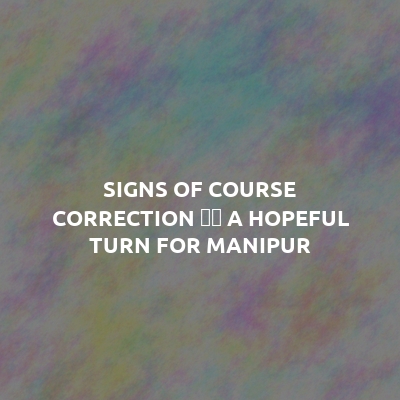It is better than never. The recent statement by Manipur Chief Secretary Prashant Kumar Singh regarding the unconfirmed visit of Prime Minister Narendra Modi to the state, amidst widespread speculation, is both revealing and reassuring. It underscores a shift from speculative political theatre to grounded administrative resolve. With no official communication received by the state government about the Prime Minister’s visit, it becomes clear that the Centre is being cautious—perhaps wisely so—in approaching the ongoing crisis in Manipur.
The Prime Minister’s eventual visit, whenever it happens, will undoubtedly be of national and emotional significance. However, such a visit must be more than symbolic. It must be preceded by tangible progress on the ground. The people of Manipur have endured over two years of uncertainty, displacement, violence, and political inertia. A hurried high-profile visit without substantial groundwork could risk not only appearing cosmetic but also tarnishing the image of the Central Government, particularly the BJP-led administration at the Centre. The current mood calls for substance over symbolism.
Encouragingly, signs of progress are finally visible under the President’s Rule. The Chief Secretary’s assurance that all Internally Displaced Persons (IDPs) will be resettled by December 2025—either back in their original homes or in government-provided prefabricated housing—is a critical milestone. This sets a firm timeline and reflects a level of seriousness in addressing the root humanitarian aspects of the conflict. While delays and logistical challenges are to be expected, the public articulation of a deadline itself marks a new level of accountability.
At the same time, the state’s efforts in reclaiming law and order cannot be overlooked. The recent massive recovery of illegal and looted weapons from Kuki-dominated areas is a significant success. It not only sends a strong message to those fuelling the conflict through armed means but also restores a degree of trust in the state’s ability to enforce rule of law. These actions, taken collectively, reinforce that the administration under President’s Rule is no longer passive but assertively proactive.
Equally noteworthy is the government’s decision to shift the Civil Secretariat and other key offices to Mantripukhri. This administrative move, seemingly technical on the surface, is a strong symbolic gesture. It indicates an intention to decentralize governance, promote a sense of inclusivity, and break away from the past inertia. Establishing a functioning, modern administrative centre away from the historical seat of conflict can go a long way in signalling a new beginning.
The decision to recommend the shifting of seven designated camps under Suspension of Operation (SoO) cadres further shows that dialogue, rather than force, remains a preferred route to long-term peace. This indicates an understanding that the conflict in Manipur is deeply layered—one that requires not just security responses but political accommodation and structured negotiations. Moving the camps also speaks to the state’s attempt to remove flashpoints of tension, a necessary step if normalcy is to return.
Critics may point to the absence of a popular government as a drawback, but given the fragile situation, extending President’s Rule for a bit longer seems prudent. Restoring peace and order should take precedence over electoral politics. Any move to form a popular government without healing the underlying wounds could result in further instability. A stable administration with clear objectives and the authority to act is preferable to a hastily installed government working under pressure and uncertainty.
Optimism in a time of crisis may appear naïve to some. But in Manipur’s case, cautious optimism is perhaps what the public needs most. After two years of anxiety, fatigue, and frustration, the state seems to be moving—slowly but surely—toward a solution. The recent developments are not magic solutions, but they represent a course correction. They show that with sustained administrative will, constructive engagement with all stakeholders, and transparent communication, even a long-festering crisis can be addressed.
As we await clarity on whether the Prime Minister will visit, or when the state will return to popular rule, one thing remains certain—Manipur is no longer on pause. The system is responding, the gears are turning, and hope, once dimmed, is cautiously being rekindled.
Signs of Course Correction – A Hopeful Turn for Manipur
24



